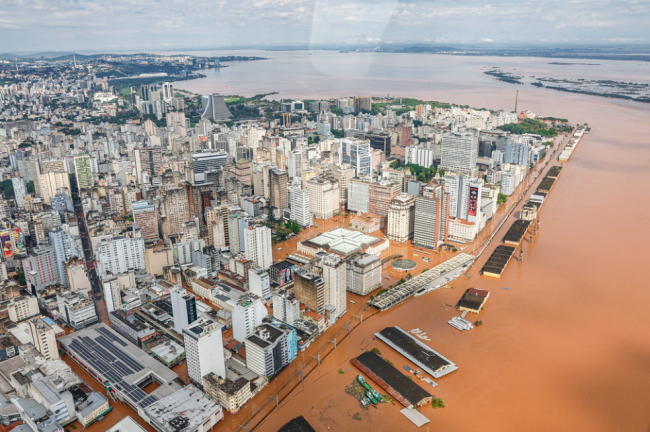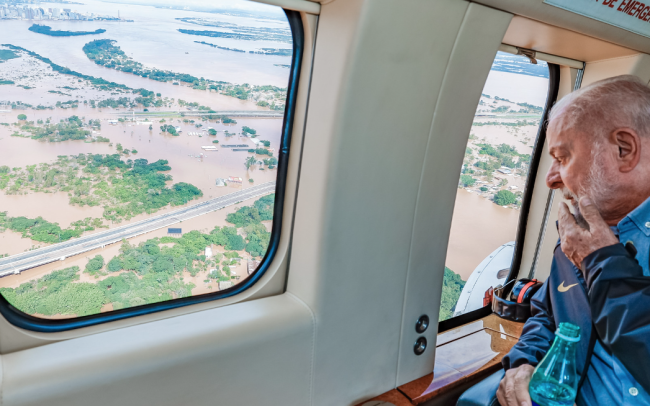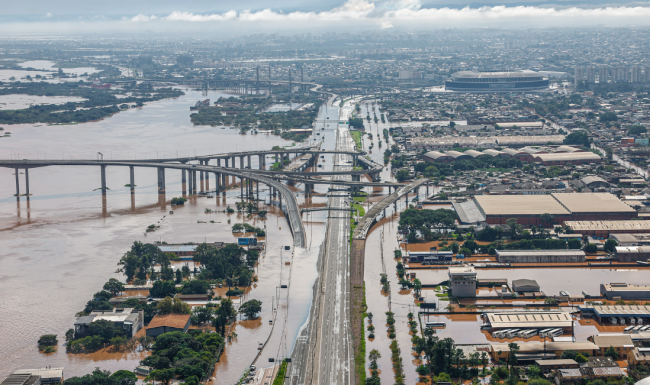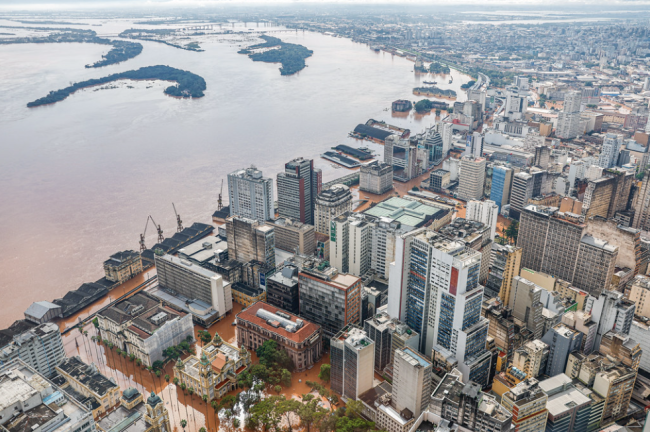
Southern Brazil is facing its worst climate tragedy ever. Unprecedented floods have impacted 1.4 million people and forced more than 160,000 people from their homes. As of May 7, at least 95 people have been killed and 130 people remain missing.
The images are shocking. Downtown Porto Alegre, the capital of the Brazilian state of Rio Grande do Sul, is underwater. The water level in the city’s Guaíba River surpassed the historic 1941 flood levels by more than a foot and a half after days of heavy rain. With more extreme rains forecasted, experts say the flood waters could remain for at least the next 10 days.
On May 2, a dam collapsed, unleashing an over 6-foot-high wave and worsening flooding in the area.
President Luiz Inácio Lula da Silva flew over the disaster area on May 5 with Rio Grande do Sul’s Governor Eduardo Leite. The following day, Lula asked Congress to declare a public calamity in the state, which would open up additional government spending. Leite says the state “will need a type of Marshall Plan for reconstruction.”
Although the tragedy is a natural disaster, experts have pointed out that the lack of preparedness on the part of state and local officials may have contributed to the devastation. According to one report, Porto Alegre slashed funds for flooding prevention over the last three years and didn’t spend a cent on it in 2023.
On May 5, I spoke with Paulo Brack, a professor at the Federal University of Rio Grande do Sul Institute of Biosciences and general coordinator of the Gaucho Institute of Environmental Sciences (InGá). He lives in Porto Alegre. In this interview, he describes the factors that have contributed to worsening the destruction of the floods and what needs to be done to mitigate similar outcomes in the future. Our conversation has been translated from Portuguese and edited for length and clarity.
Michael Fox: Paulo, what happened to lead to the tremendous climate disaster Porto Alegre and the state of Rio Grande do Sul is now facing?
Paulo Brack: There was a climatic event here with torrential rain that exceeded 300 mm in a few days. It reached almost 400 mm depending on the region. Torrential rains and floods were widespread. They severely hit the Taquari-Antas River valley for the second time in a year. The situation then was not on the same level as now, but it was very violent, because the rains came very fast and caused more than 50 deaths.

What has happened now was due to a series of climate factors—climate change, of course. We are at the end of El Niño, and we've had very large evaporation of water from the Pacific Ocean. The arrival of this humidity here is also due to the warming of the Pacific Ocean and a current of humid air from the Amazon. When cold fronts come from the south, they generally rise up through Brazil. They start here in Rio Grande do Sul, then go up to Santa Catarina, Paraná, and so on. But this was interrupted. There was an atmospheric blockage.
This atmospheric blockage is also partly related to overheating in the central region of Brazil. This is related to deforestation and the lack of vegetation. The environment is also very dry in central Brazil. So this created what is called a heat dome, which blocked these rains here and prevented them from traveling up to the other states. They were stuck here, over this state. So it rained a lot in just a few days. And at the same time, there was this blockage that prevented some of these rains from being distributed among other states in the Southern region.
The rains were so intense also due to the effect of the ever-increasing greenhouse gasses. We had the highest temperatures [ever recorded] last year. The Atlantic Ocean also saw its highest temperatures. We knew that things were going to get worse, but it all seems to be happening really quickly.
MF: How has the response been from local and state officials? Were they prepared?
PB: They are just making it up as they go along. In Porto Alegre, we have dikes, floodgates, and pump houses that weren’t maintained and so weren’t working properly. There was a huge lack of preparation on the part of the city hall. We used to have a river sewage department, but it was extinguished. And unfortunately, there was no preparation from the municipal government here in Porto Alegre, or the state government. It’s the same in the interior of the state, with some exceptions. It looks like São Leopoldo took some initiatives to prepare. But, in general, there is no culture of prevention.
So this is a problem of Brazilian culture—the absence of stable public policies and structures to be able to respond quickly to emergencies in the medium term. And at the same time, we also need preparation in the long term. Because from now on, climatic events will continue to occur with the same or even worse intensity.
What catches our attention right now is that, once again, after heavy rains in September and December of last year, the state government has not shown the least concern for creating a protocol or developing a strategy to confront this issue. It seems as though state officials are just improvising in response to these events.
A few days before the heavy rains on September 4, last year on August 30, the National Meteorologist Institute (Inmet) had warned that the coming rains could be very intense. Between 300 and 500 mm could fall in just a few days, which would be a historic situation—never seen at that time. I was terrified when I read this news at the end of August. Days later, it caught my attention that I hadn't seen any statement from the state government.
Unfortunately, the institute was right. A historic phenomenon occurred at that time. And the government didn’t take the necessary measures. No one was prepared in the regions where these rains were predicted. There was inaction on the part of the government.
And what’s happening now is on an even greater scale.
MF: Is there sufficient legislation to mitigate potential floods like this?
PB: The Guaíba—I consider it both a river and a lake. According to the Brazilian statistical institute IBGE, it is still considered a river, but in the Porto Alegre Environmental Atlas, they call it a lake. Regardless, it has characteristics of both, particularly in the northern part, close to Porto Alegre.
It is a waterway and it should, according to legislation, be well protected, with permanent preservation areas. From an environmental point of view, the margins of the waterways should be protected. We have reasonably good legislation, but it is not being enforced. And unfortunately, the laws are being rolled back. So this all increases the consequences even more when very intense rains fall on soils where vegetation has been removed.
The buffer areas—wetlands, forests—are being occupied [by humans] very quickly. Here in the northern part of Porto Alegre, including the area most affected by the rains, they are building a very large landfill in wetlands that are part of the Gravataí River. And it is precisely the Gravataí River that has spilled over, affecting thousands of people and impacting several neighborhoods, both in Canoas and also in northern parts of Porto Alegre.
So, poor use of land, due to improper occupations and also due to agriculture in the Taquari-Antas River headwaters, is one of the main factors that has caused this problem. A hydroelectric dam, called 14 de Julho, even collapsed. We’re lucky it wasn't worse. The rains downstream of the dam had already elevated the level of the Taquari River, so the difference in the water level was not that high when the dam broke.

MF: What needs to happen now?
PB: What we need is a climate emergency decree. This was actually requested last year. Environment Minister Marina Silva herself spoke in recent days about the need for a climate emergency decree here in Brazil that could facilitate spending to attend to the needs of the most affected people. It's a package of things—basic health care and equipment, roads, projects. Here in Porto Alegre, for example, the asphalt broke on BR 290, one of the two largest roads. There’s a huge crater. Also, on the way out of Porto Alegre to the north, on Avenida Castelo Branco, another crater has also opened up in the asphalt.
Several of the main access roads to Porto Alegre are out of commission. Flights at the airport have been canceled. It's flooded too. So the airport is closed until the waters go down.
MF: Has Brazil allocated sufficient resources for climate emergencies and climate change?
PB: At the national level it is very contradictory and ambiguous, at least at the level of the federal government. The government played an important role and gave beautiful speeches at COP 28. But at the same time, in the same week, there was an auction for oil rights. So it's very contradictory, because, unfortunately, even the left-center governments of Brazil are obsessed with development, sometimes according to the conventional model. We call it developmentalism, and the environmental part remains in the background. There is no planning.
[Governments] develop large plans for infrastructure to generate energy, but there are no plans to reduce energy consumption, which is the basis of greenhouse gas emissions. If we don't reduce energy consumption we will continue, for the most part, emitting greenhouse gasses. And this is an issue that goes to the root of the problem. This is a model of society—societies based on consumption, where reducing energy use is not within the programming of governments and companies. On the contrary, energy consumption just continues to grow. So it is very contradictory.

MF: What else is important right now?
PB: In the Chamber of Deputies, as well as the Senate, there are a series of bills that would weaken our forest protections even more. We are very concerned about the high-altitude areas that are part of the Atlantic Forest Law.
Congress is stripping the protections in these areas and allowing agriculture to advance. We know that soybeans, for example, have been a very important commodity here in Brazil. The advance of soy at the headwaters of the Guaíba River and the Taquari-Antas River is very drastic. This also brings erosion and waterproofs the soil, which means less water is filtered into the soil, causing greater runoff.
With more water runoff, there’s more mud being carried away. And we see from the photographs of the impacted cities that there’s a large quantity of mud. This mud is an indicator of poor land use.
Everything indicates that it is necessary to adopt public policies to protect these areas and to reduce construction next to the waterways. A few years ago, the Havan department store was built right on the banks of one of the most affected rivers, the Taquari River, in the city of Lajeado. It was built precisely in the permanent preservation area.
At the time, there was an outcry from environmentalists saying that the store was occupying an area where the river overflows. It was built there, waterproofing the soil, and causing even more problems. And this building was one of the most affected here, precisely because it was built in that spot. So we see that there have been a series of laws [and proposed laws] reducing environmental protections, not only for high-altitude areas, as I mentioned, but also in the reduction of permanent preservation areas.
There was already a law approved about two and a half years ago in Congress that allows each municipality to determine the range of permanent preservation area. We consider that this has given permission for municipalities to reduce what the so-called Forest Code determines. Law 12651 is a super important law for the protection of watercourses, but now each municipality can opt to reduce these [protected] areas [on a case by case basis].
So, these are contradictions. On top of the culture of non-prevention—not thinking about the future, but rather the immediate—you also have business interests trying to roll back the strength of legislation, which will lead to more serious events like this in the future.
And climate denialism continues. It persists. There are some senators, including one of the senators here from Rio Grande do Sul, Luiz Carlos Heinz, who says he doesn't believe in climate change. So that’s a reality here, just like in the United States.
We have a series of issues that are blocking us from having even the minimal conditions to face climate disasters, and to not see so many deaths due to a lack of action on the part of governments.
Michael Fox is a Latin America-based multimedia journalist and host of the podcasts Under the Shadow and Brazil on Fire. He was previously editor of NACLA. He tweets at @mfox_us.

